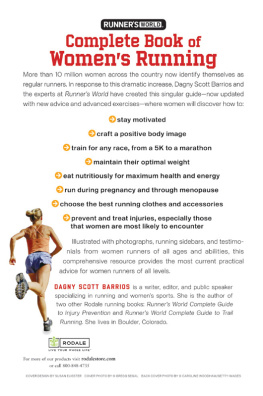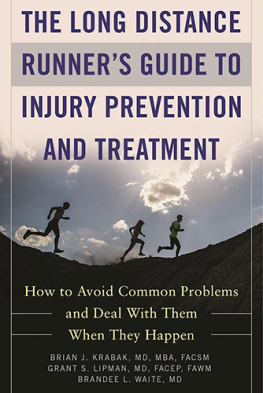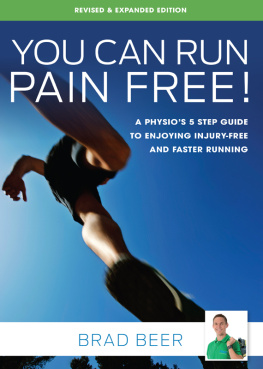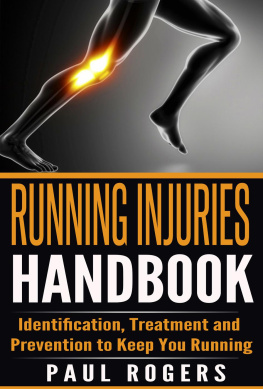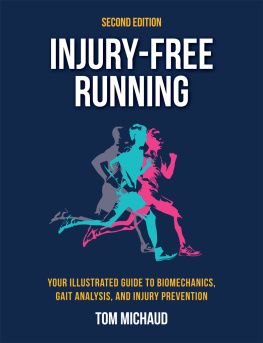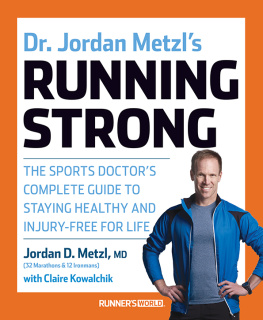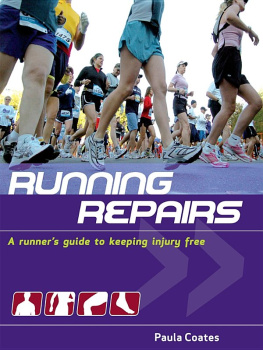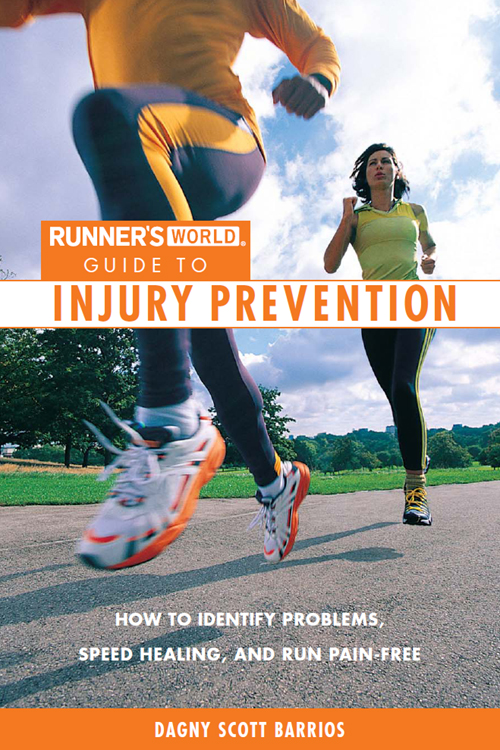For every runner who ever struggled through an injurywhich is to say, pretty much all of us
CONTENTS
ACKNOWLEDGMENTS
A heartfelt thank-you to all the running professionals who took their time to help with this book. Tim Hilden and Neil Henderson of the Boulder Center for Sports Medicine truly have the best interest of runners at heart. I thank them for agreeing to provide the expertise behind the strength and stretching portions of the book. Thanks also to Mark Plaatjes, Lewis G. Maharam, Paul Thompson, Jordan D. Metzl, Stephen Rice, Christine Wells, Margaret Karg, Matthew Callison, Yun-Tao Ma, Cynthia Ribeiro, Walter Bortz, John Cavanaugh, Bruce Wilk, Larry Grollman, Deborah Lee Greenslit, Jane Welzel, Rodger Kram, Michael Sachs, Christine Epplett, and Irene McClay Davis for being so graciously forthcoming with information, assistance, and advice. I am especially grateful to Philip Stull and Thomas Shonka, who served as arbiters on medical issues.
The wonderful team at Runners World and Rodale Books ensured that this work would be as helpful to runners as possible. Thank you to copy editor Jean Rogers and project editor Kathy Dvorsky for managing the important details. As ever, a huge thank-you to Leah Flickinger for her excellent editors eye and touch.
The runners in my life deserve special thanks: My husband, Arturo, and my training partners, Sarah Krakoff and Karen Franklin, have, once again, patiently and supportively listened to endless miles worth of my birthing a book. Finally, thank you to my daughter, Bianca, for waiting patiently while Mommy types.
INTRODUCTION
Injuries. I've had my share. Lets review the damage.
1994: Iliotibial band syndrome. Caught the competitive bug and bumped up my mileage recklessly like a true zealot. It was my first major injury requiringyikes!time off. Depression set in. Lets just say I wasnt pleasant to be around.
1996: Plantar fasciitis. The pain in my heel gets so bad that I can barely walk to work, much less run. I lose half a year of training, not to mention plenty of enthusiasm. Finally, a second pair of customized orthotics and a night splint save the day, and Im back in business.
1997: Achilles tendinitis. Completely avoidable and utterly idiotic. But Im training as hard as I ever have and running personal records in my thirties, so of course time off isnt even a consideration. Eventually, I dont have a choice, as my tendon is doubled in size and raw to the touch. Okay, time for a break.
1998: Stress fracture. No warning signs for this onea metatarsal bone just had enough of hard training. Tests showed no lacy, aging bones, so nutrition wasnt the issue. However, subsequent x-rays also revealed a cracked sesamoid bone in my other foot. No wonder thats been hurting for, oh, say, 6 months or so.
Okay, you get the point. I wont even bother mentioning the high school or college years. Or the little everyday strains and niggling pains. These are just the highlights of my adult competitive career, the injuries I can mark the years by without even looking back at my training logs.
Embarrassing? Yup. Especially now that I can see how silly and avoidable most of these injuries were. Had I taken proper measures at the onset of pain, rather than barreling heedlessly forward with my training, I could have avoided a lot of agonyand ultimately taken less time off.
The good news is that Ive learned from my mistakes. As my running career has matured, so has my outlook. And amazingly enough, I havent had any debilitating injuries since that stress fracture in the late 1990s.
So what has made the difference between life as a string of injuries and running injury-free? If I had to boil it down to one thing, it would be this: paying attention to and respecting the signals my body sends, rather than ignoring them. Last summer, for example, when I felt a strain in my calf during a track workout, I immediately changed out of my racing shoes and into my heavy trainers. I tried one more 400-meter repeat. Nope, still hurt. I walked off the track without finishing the workout, went home and iced, and then took the next day off. Forty-eight hours and a little more ice later, I jogged an easy 30 minutes with no calf pain whatsoever. Years ago, I would have ignored the warning signs, toughed out the track workout, and suffered a full-blown muscle pull.
Of course, I still do some unwise things when my training is heating up. We all do. But as our legs acquire years of training, we learn that our body never lies. And we ignore its messages at our own peril. Running injuries are not inevitable, but they become more or less probable based on things like your levels of patience and obsession and your ability to listen to (and trust) your body.
Even with smart training and proper attention to biomechanics, nobody can guarantee that youll never get injured. Instead, here are some good and reasonable goals for you as a runner.
- To reduce the chance of injury
- To recognize injuries early and thus minimize damage
- To treat injury appropriately and address the underlying causes
- To return to running in a manner that discourages future injury
These four goals are addressed throughout this book. Accomplish these things and, while you might not remain injury-free, you will certainly maximize your running enjoyment and keep injuries from excessively hampering your running career.
INJURY 101
THE BIG IMPACT OF LITTLE THINGS
A simple footstep. Its the most basic component of running. Nothing fancy about that. Running is one footstep after another. But have you ever considered just how many times you ask your body to repeat that simple act during a run? Heres an eye-opening bit of calculation.
The average distance runner covers about a yard with each step during traininganywhere from 2.5 to 4.5 feet. That translates to 1,000 to 2,000 total steps per mile, which means the runner lands on each leg 500 to 1,000 times per mile. On a typical 5-mile run, each leg will land 2,500 to 5,000 times. A runner who covers 5 miles 5 days per week, therefore, will land on each leg 650,000 to 1,300,000 times in a year. And thats just someone covering 25 miles a week. A runner training for a marathon whos regularly putting in training of 50 miles a week can easily strike the ground well over 2 million times per leg each year.
Over the course of your running life, how many times will each leg hit the ground? Well, you know how long youve been runningas they say, you do the math. Its not unusual for a longtime runner to literally take tens of millions of steps.
A little shocking, isnt it? And when viewed that way, its no surprise that most runners will eventually suffer some injury. In fact, researchers estimate that injury strikes a quarter to half of all runners each year.
THE INJURY EQUATION
Running injuries arent like football or skiing injuries. When we say half of all runners suffer injury each year, most are not sidelined in a cast. No, running injuries are decidedly less dramatic, if more insidious.
Many running injuries are not even noticeable when youre walking or going about other day-to-day activities. They make themselves known only when you start running. Thats because in running, injury stems primarily from all those little stepsthose millions of little stepsadding up to exert forces that at some point aggravate some link in the structural chain that makes up the running stride. Other factors that contribute to getting hurt include how the body adapts to wear and tear, the weight of each footfall, and the muscle power required to put one foot in front of the other at a good clip. Lets take a look at each factor and its role in the injury equation.


